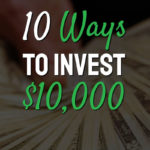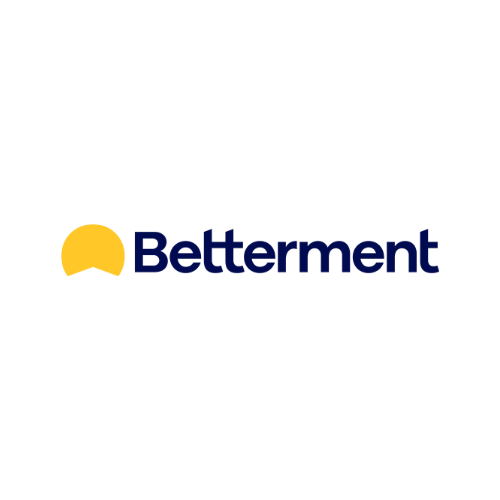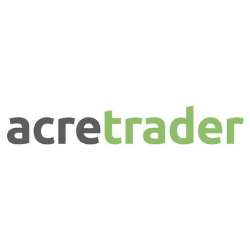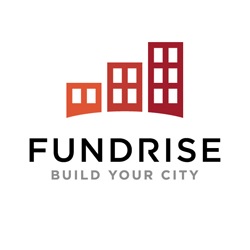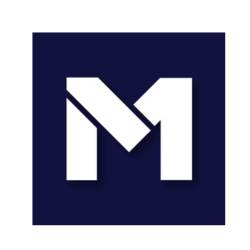10 Best Ways to Invest $10,000
Some products in this article are from our partners. Read our Advertiser Discloser.
There are many ways to invest $10,000. What would you do with it?
There’s a lot you could do with it to help it have a big impact on your financial life.
Sure, it’d be easy to find something fun to do with that money. Go on a vacation. Buy a nicer car. But I’d like to encourage you to invest more money into your future.
Now is the time to make your short and long-term goals more financially secure.
Here are a few of our top investment ideas you can consider when investing $10,000.
Ways to Invest $10,000
The great thing about most of these investment opportunities is that you don’t need to have $10,000 to invest in them! Some of them even have a zero minimum investment requirement.
1. Low Fee Investment Firm
Full-service investment firms can take a huge bite out of your potential for investment profits when you calculate their annual and other fees. In fact, it’s not uncommon for some investment firms to charge 1.5 percent or more in annual and other fees.
However, you can invest money in stocks, bonds, mutual funds and more without paying high fees. As an example, Betterment helps you invest in ETFs (exchange-traded funds).
There’s no minimum balance to invest with Betterment, and the company’s annual fee for investors is only 0.25 percent. And it’s a fiduciary firm, which means it’s legally bound to act in the best interests of its investors.
Wealthsimple is another robo-advisor firm with low fees. The minimum opening balance requirement with Wealthsimple is just $1. And the annual fee for the Wealthsimple Invest is only 0.50 percent.
They also have a Wealthsimple Save account with an yearly fee of 0.25 percent. The Save account invests your money in low-risk, short-term ETF funds.
Wealthfront is another robo-advisor that offers attractive fees. Like Betterment, Wealthfront charges an 0.25 percent annual asset management fee. However, the minimum to invest with Wealthfront is $500.
2. High Yield Savings Account
Are you looking to invest a lump sum of cash with little or no risk? If so, you might want to consider investing in a high-yield savings account.
High-yield checking accounts and money market accounts are also options you have to earn some low-risk returns on your investment.
These options for investing your lump sum of money can be great if you want to use that cash to increase your emergency fund.
They can also be good choices if you are saving for a purchase you’ll make in the near future.
For example, let’s say you’re saving to:
- Buy a house
- Take a vacation
- Purchase a vehicle
- Remodel your home
You know you’ll need the money within a year or two, so you don’t want to tie it up in some type of long term investment. You also know that you don’t want to take a chance on losing it because you have a purpose for the money.
For that reason, you want to avoid higher-risk investments, but you also want to make some cash off of the money until you’re ready to use it.
In cases like that, high yield savings accounts–or even shorter-term CD’s–can be smart choices for investing your $10,000.
More on that later.
3. Farmland
Many savvy investors invest their money in farmland. Farmland has a pretty solid history of investment returns over the last 30 years or so when they started tracking farmland investing returns.
When you invest in farmland, you buy acreage that farmers use to grow and sell crops. Then you get a piece of the profit when the crops sell.
Usually, you’d have to buy an entire piece of land yourself and rent it out to invest in farmland. However, companies like AcreTrader let you invest in pieces of farmland.
With AcreTrader, you buy shares of land that typically encompass between one and four acres or more. The shares have a 3 to 5-year maturity date.
At that time, you can cash out and get your money or reinvest in more farmland. Because you’re buying just part of a farmland parcel, you can invest with as little as $10,000, and sometimes less depending on the price per acre.
AcreTrader charges an annual asset management fee of 0.75%, and you take any profit leftover from there. The AcreTrader website says farmland has a historical average return of 11.5%.
Now, you might not earn that much with AcreTrader, but then again, you might. Land is almost always valuable. As Mark Twain once said, “Buy land. They’re not making it anymore.”
AcreTraderDisclosure: “This is a sponsored promotion for the AcreTrader platform. Well Kept Wallet may have investments in companies represented on the AcreTrader platform. This informational is by no means a promotion, solicitation, or recommendation of any specific investment.”
4. Small Business
One way to invest $10,000 that could be beneficial is to invest it in a small business. Now, you might not want to sock all ten grand into a business. Like any other investment, investing in small companies can be risky.
However, there are other options. One is to invest in Worthy Bonds. The Worthy Financial company created Worthy Peer Capital, which loans money to small business owners.
Worthy sells Worthy Bonds to investors to raise capital for their small business loans. The loans Worthy makes are always secured by assets having a greater liquidation value than the loan.
Investors can buy Worthy Bonds for as little as $5 each. All Worthy Bonds earn a return of five percent. While that’s not a huge return, it’s definitely more than you’ll get in a high-yield savings account or CD.
5. Health Savings Account
Are you eligible to open an HSA (Health Savings Account)? To be eligible to open and contribute to an HSA, you need to meet the following criteria:
- Be 18 years of age or older
- Are enrolled in a qualifying HDHP (High Deductible Health Plan)
- Are not enrolled in any other health care plan (including Medicare and Veterans coverage)
- Not enrolled in a Flexible Spending Account or Health Reimbursement Account
Contributions to HSAs are tax-deductible. And withdrawals from an HSA are tax-free as long as they’re used for qualifying medical expenses. There’s no minimum withdrawal age or amount for your HSA, which means you can let the money sit until you need it.
One company that can help you open an HSA if you qualify is Lively. Lively is a no-fee HSA provider that will work with you to maximize your HSA contributions through your Lively account.
Bonus: Some self-employed persons can open HSAs too. Check with your tax accountant for details.
6. Real Estate
We talked earlier about investing in farmland. However, you could use some or all of your $10k to invest in other real estate types.
Now, you’re probably not going to buy an actual house or business with ten grand. However, some companies can help you purchase pieces of actual real estate for smaller amounts of money.
For instance, crowdfunded real estate investing companies like Fundrise sell shares of residential and commercial real estate properties. Crowdfunded real estate investing is where a bunch of investors get together to buy a piece of property.
You can invest in crowdfunded real estate with Fundrise for as little as $500, and Fundrise accepts both accredited and non-accredited investors.
7. Peer to Peer Lending
Similar to crowdfunded real estate, crowdfunded lending companies help you to invest in pieces of loans made out to borrowers. Borrowers come to a website such as Lending Club to get a loan.
When they’re approved, Lending Club offers pieces of that loan to investors. As the borrower pays back the loan, investors get their initial investment back, along with any profit.
Typically, crowdfunded lending institutions have loan investments available that vary in risk level. You can invest in a higher grade (i.e., lower risk) loan that pays a lower interest rate.
Or you could invest in a lower grade (i.e., higher risk) loan that pays out a higher interest rate. Of course, your risk level with the lower grade loans is greater.
In other words, there’s a greater chance that the loan won’t get paid back. However, there’s also the potential for a greater return on investment. As with any investment, it’s essential to read the fine print and understand your risks before investing.
8. Roth IRA
Have you maxed out your Roth IRA or Traditional IRA contributions for the year? If not, you could use some of your $10k to do that. The maximum IRA contribution level for 2020 is $6,000, $7,000 if you’re age 50 or older.
You can split your maximum contribution amount between any kind of Roth or Traditional IRA. Open an IRA with your investment firm, or check out M1 Finance. M1 Finance helps you invest in stocks and funds you want to invest in. You can even invest in fractional shares of stocks.
M1 Finance and similar investment firms are self-directed and allow you to customize a diverse portfolio that fits your investment needs at a fraction of traditional investment firms’ fees.
For more on IRAs, how to open one and where to invest in one, check out this IRA how-to guide.
9. CD/Bond Ladder
Another option for investing your $10k is to create a CD or bond ladder. CD and bond ladders are investment strategies that involve purchasing CDs or bonds with varying due dates.
They’re all typically shorter term lengths, but they have different due dates, so you’ll always have the option to have some money available to you. But you can do so while earning a higher rate of interest on your cash.
Example of a CD ladder:
- 6-month CD
- 9-month CD
- 12-month CD
- 15-month CD
- 18-month CD
And as each one comes to maturity, you’ll have the option to reinvest it into another term with a different due date from your other CDs. Or you can cash it out and put it into a high-yield savings account or sinking fund.
CD ladders are a great way for you to invest so that you can earn more interest without tying up your money for long periods. Look online for the best CD rates as you choose to open the CDs for your CD ladder.
Since you don’t have to have all of the CDs at the same bank to create a CD ladder, you can take advantage of the best banks’ best rates for each term you need.
10. Your Employer’s 401k
If your company has a 401k plan, it’s worth it to take advantage of that. For one thing, 401k contribution limits are much higher than IRA contribution limits.
While annual IRA contribution limits typically run around $6,000 or so, 401k contribution limits are closer to $20,000 per year. And that doesn’t include any employer match funds, which you should take advantage of.
By contributing to your 401k and any IRA contributions, you can quadruple your retirement savings. So if you’re not maxing out your 401k contributions yet, consider using part of your $10,000 bounty to do so.
Talk with your employer about making a lump sum contribution to your 401k account.
Note that you can’t just write a check to your 401k account in most cases unless you’re paying off a 401k loan.
However, you can increase your contributions to the maximum allowed until you’ve contributed that lump sum amount to your 401k account.
Talk to your company’s human resources department about how to do that.
Summary
There are many ways you can invest small or large amounts of cash that will benefit your future. Choose to save and (or) invest some of each paycheck, as well as any lump sums of money you might receive.
By doing so diligently and regularly, you create a solid financial future for you and those you love.

